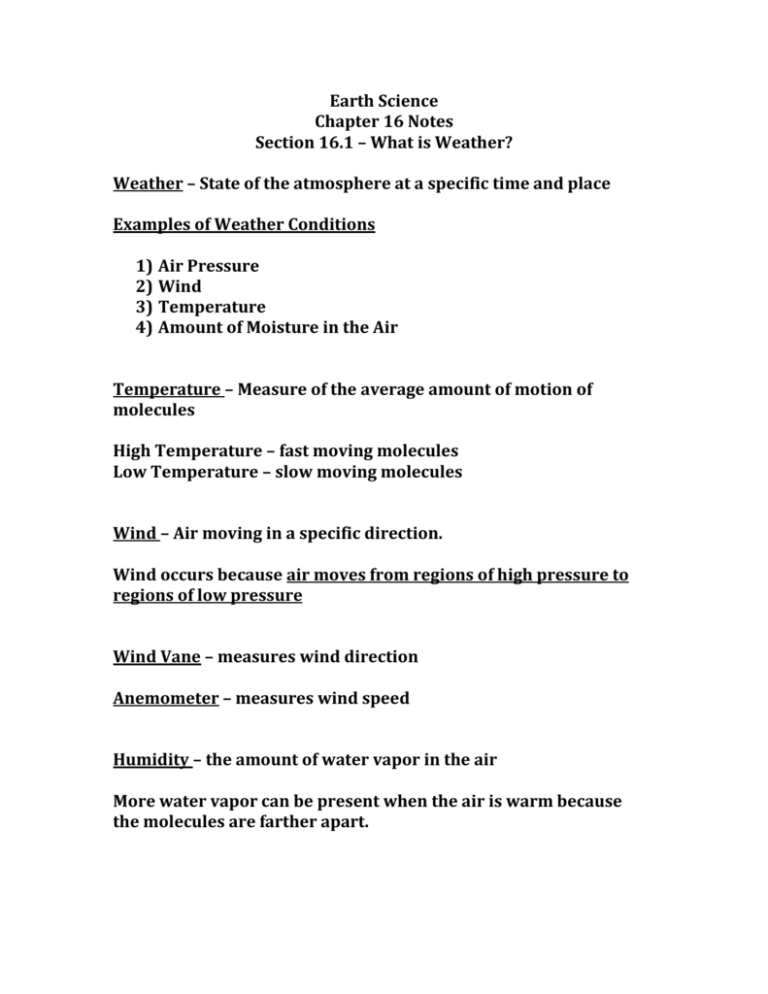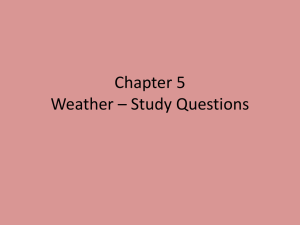Earth Science Chapter 16 Notes Section 16.1 – What is Weather
advertisement

Earth Science Chapter 16 Notes Section 16.1 – What is Weather? Weather – State of the atmosphere at a specific time and place Examples of Weather Conditions 1) Air Pressure 2) Wind 3) Temperature 4) Amount of Moisture in the Air Temperature – Measure of the average amount of motion of molecules High Temperature – fast moving molecules Low Temperature – slow moving molecules Wind – Air moving in a specific direction. Wind occurs because air moves from regions of high pressure to regions of low pressure Wind Vane – measures wind direction Anemometer – measures wind speed Humidity – the amount of water vapor in the air More water vapor can be present when the air is warm because the molecules are farther apart. Condensation – Forming liquid water from water vapor The air becomes saturated when condensation takes place. Relative Humidity – Measure of the amount of water vapor present compared to the amount needed for saturation at that specific temperature Dew Point – the temperature at which air is saturated and condensation forms. Dew point changes with the amount of water vapor in the air. When temperatures are near 0℉ - frost forms Forming Clouds – clouds form when air is forced up, expands and cools. Classifying Clouds Clouds are classified by: 1) Shape 2) Height 3 Main Types of Clouds 1) Stratus 2) Cumulus 3) Cirrus Stratus - Form layers or smooth even sheets - Fog is a stratus cloud that has cooled to its dew point - Form at low altitudes - Occur during fair weather, rain or snow Cumulus - White puffy clouds with flat bases - Fair weather or thunderstorms Cirrus - Fibrous or curly - High, thin, white feathery clouds - Fair weather – can indicate approaching storms Height Prefixes - Cirro – High clouds – Example - cirrostratus - Alto – Middle clouds – Example – altostratus - Strato – low clouds Nimbus – Dark rain cloud – Water content is so high that light can’t pass through them Cumulonimbus – Thunderstorm cloud Nimbostratus – Layered clouds that bring steady rain or snow Precipitation – Water falling out of clouds – Occurs when cloud droplets grow large enough to fall from Earth Size of Raindrops Depend on: 1) Updrafts in a cloud 2) Rate of evaporation 4 Main Types of Precipitation 1) Rain – drops of water falling in temps above freezing 2) Snow – drops of water falling in temps below freezing 3) Sleet – Raindrops pass through a layer of freezing air 4) Hail – forms in cumulonimbus clouds








